It’s Sunday morning and we are sitting on a mooring here in Le Saintes, a small archipelago of French owned islands off of the coast of Guadaloupe. These islands, as are much of the eastern Caribbean island chain, are remnants of ancient volcanoes, a few, that are still somewhat active.
However, Le Saintes are much older, in geologic time, so have worn down to a fraction of their original elevation. You can still see clearly, in some of the rock outcroppings, their volcanic origins. This shot, of nearby Pain de Sucre surely looks like the remnants of something thrust up from deep in the earth. 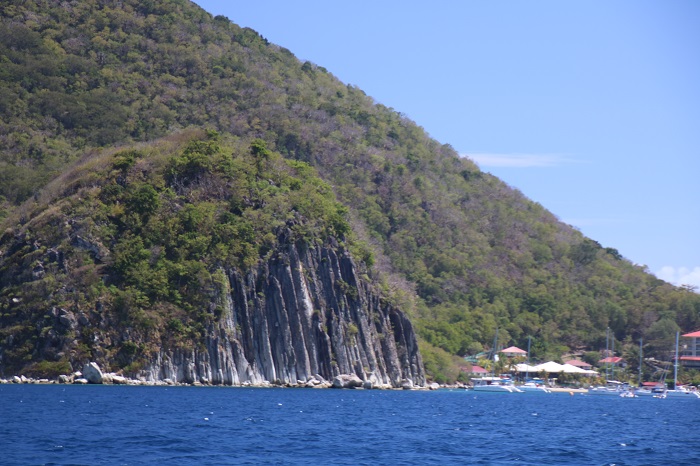 The town we are visiting, the largest in Le Saintes is called Bourg de Saintes. This collection of islands is actually a part of Guadaloupe so we didn’t have to check in after leaving Guadaloupe. The waterfront is lined with quaint little shops and restaurants. It’s very popular with tourists who come over from the mainland by the ferry full all day long to enjoy the beaches and village.
The town we are visiting, the largest in Le Saintes is called Bourg de Saintes. This collection of islands is actually a part of Guadaloupe so we didn’t have to check in after leaving Guadaloupe. The waterfront is lined with quaint little shops and restaurants. It’s very popular with tourists who come over from the mainland by the ferry full all day long to enjoy the beaches and village.
Doesn’t it just look so Mediterranean?
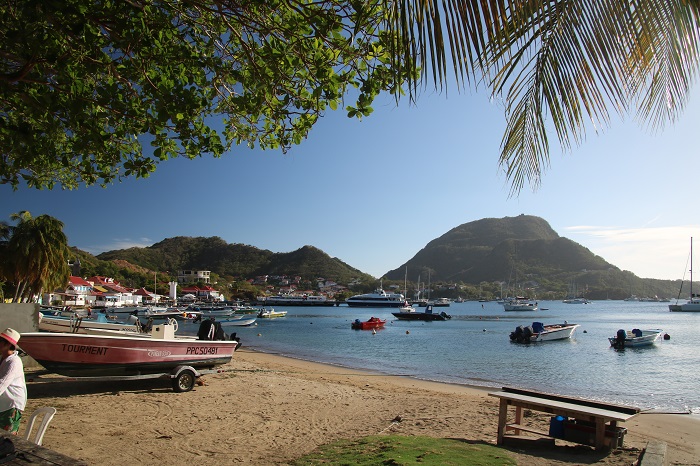 The water in the harbor is really too deep, at about 45′, for anchoring so they have put in moorings nearly everywhere. That’s probably the best thing and they don’t cost much, less than $15/day for a boat the size of Pandora, less if you stay a week. There are more boats than moorings though, so it’s a race to see who can get to an open mooring when one opens up. The other day we raced to try and get the only open one only to have a local launch roar up in front of us to snag it for someone else. “Saved seat!”. They reminded me that there was plenty of space to anchor about a mile from town. Thanks a lot as it’s a wet run to town. The moorings are much better.
The water in the harbor is really too deep, at about 45′, for anchoring so they have put in moorings nearly everywhere. That’s probably the best thing and they don’t cost much, less than $15/day for a boat the size of Pandora, less if you stay a week. There are more boats than moorings though, so it’s a race to see who can get to an open mooring when one opens up. The other day we raced to try and get the only open one only to have a local launch roar up in front of us to snag it for someone else. “Saved seat!”. They reminded me that there was plenty of space to anchor about a mile from town. Thanks a lot as it’s a wet run to town. The moorings are much better.
Main Street is very charming. 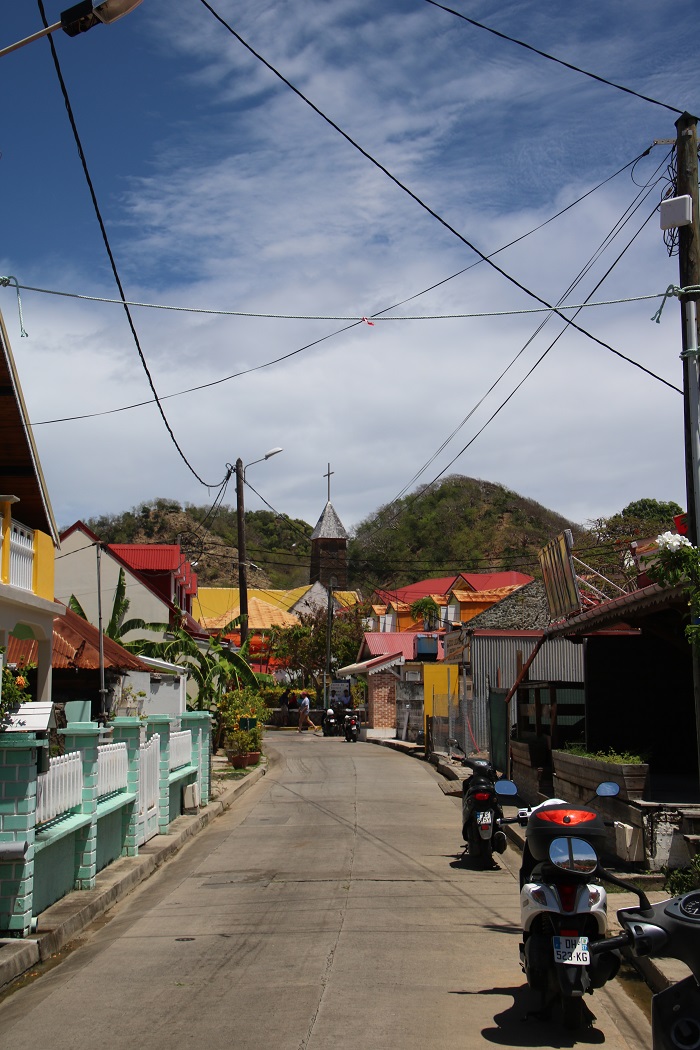
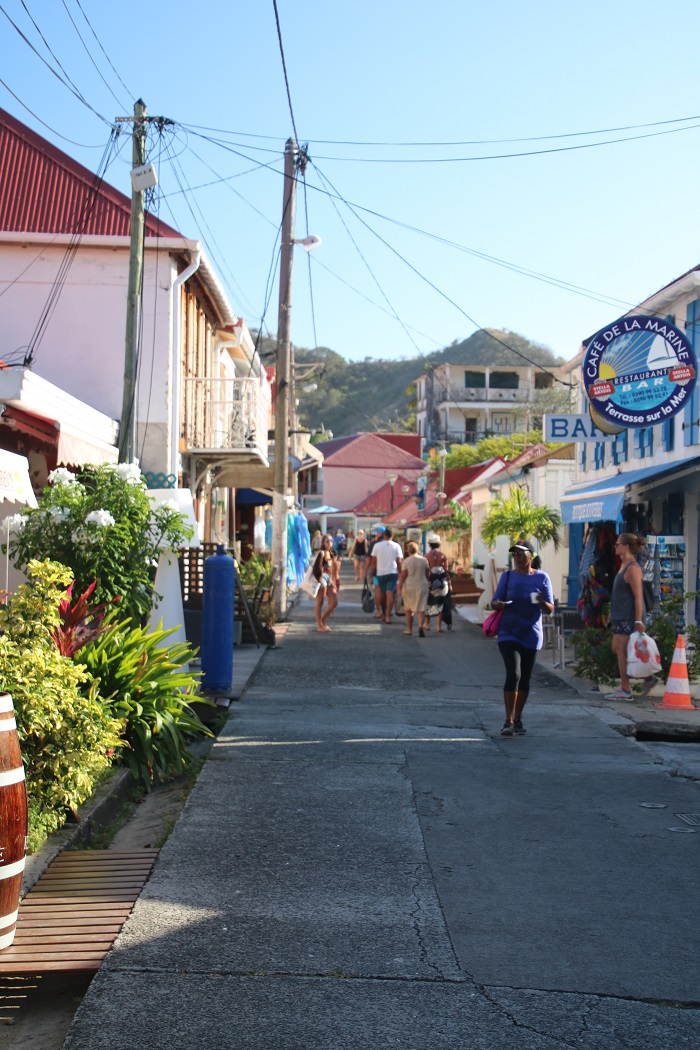 Every building painted bright happy colors.
Every building painted bright happy colors. 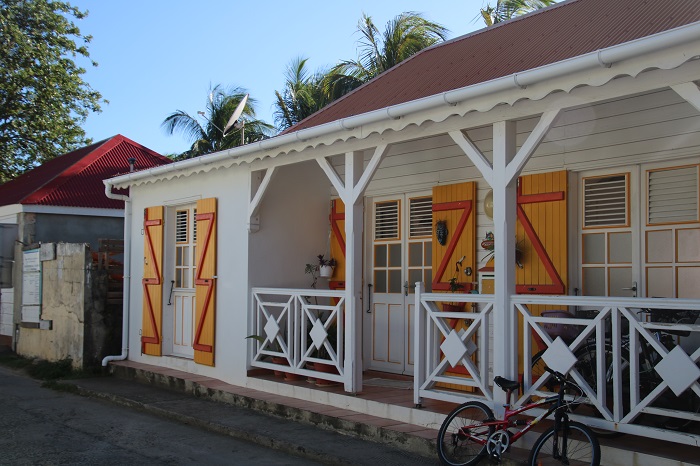 I liked this shabby chic building with a local vendor selling her hand made jewelry parked out in front.
I liked this shabby chic building with a local vendor selling her hand made jewelry parked out in front. 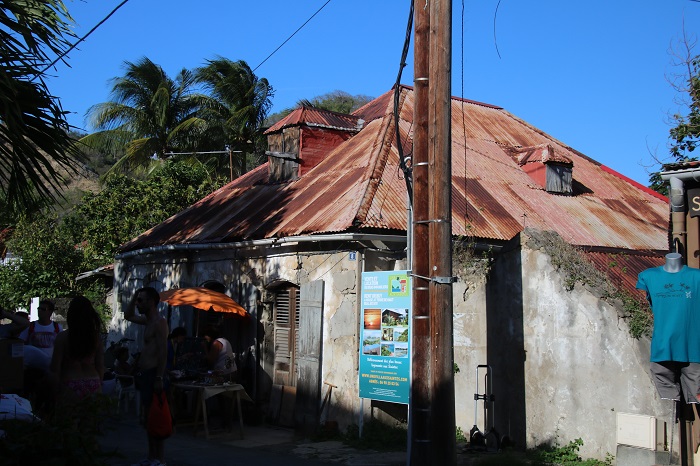 Much of the island that is just too rough and steep to build on. However, where they are homes, they adhere tightly to a particular style, red roof and all. I expect that there are strict codes to be sure that nothing is built that will threaten the local flavor, or “Frenchness”.
Much of the island that is just too rough and steep to build on. However, where they are homes, they adhere tightly to a particular style, red roof and all. I expect that there are strict codes to be sure that nothing is built that will threaten the local flavor, or “Frenchness”. 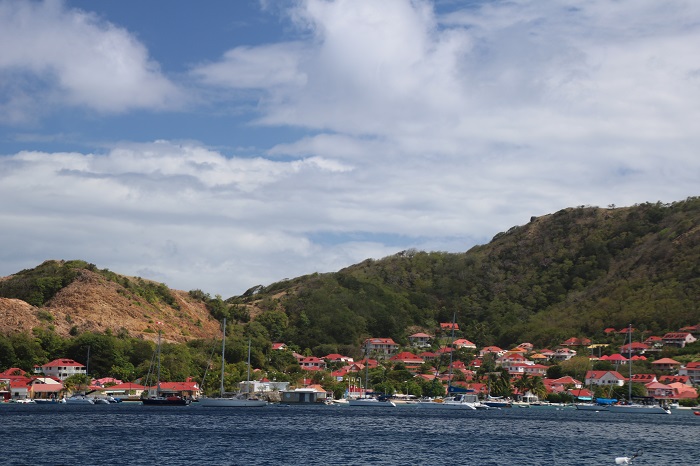 On main street there is a very nice church. Yesterday afternoon the choir was singing and it wafted out onto the street. Many tourists, including me, were milling around enjoying the sounds.
On main street there is a very nice church. Yesterday afternoon the choir was singing and it wafted out onto the street. Many tourists, including me, were milling around enjoying the sounds. 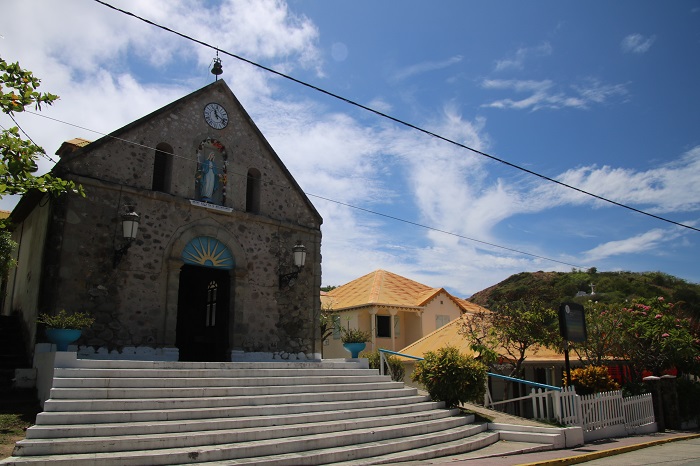 The view from the steps of the church was very soothing. Love the lamp.
The view from the steps of the church was very soothing. Love the lamp. 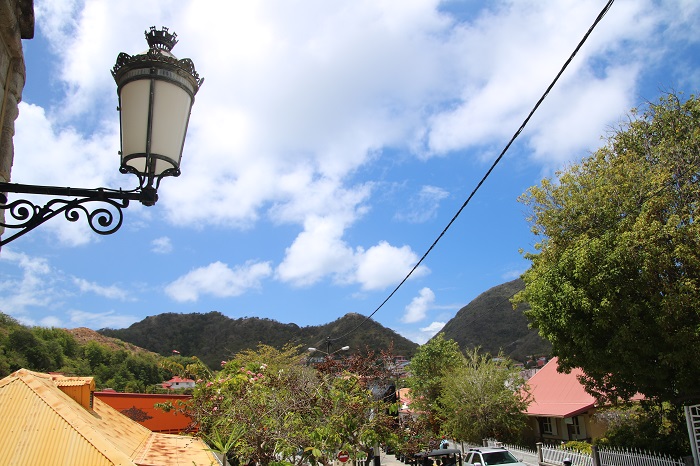 Not sure that this rooster was too focused on the music, or me, for that matter.
Not sure that this rooster was too focused on the music, or me, for that matter.
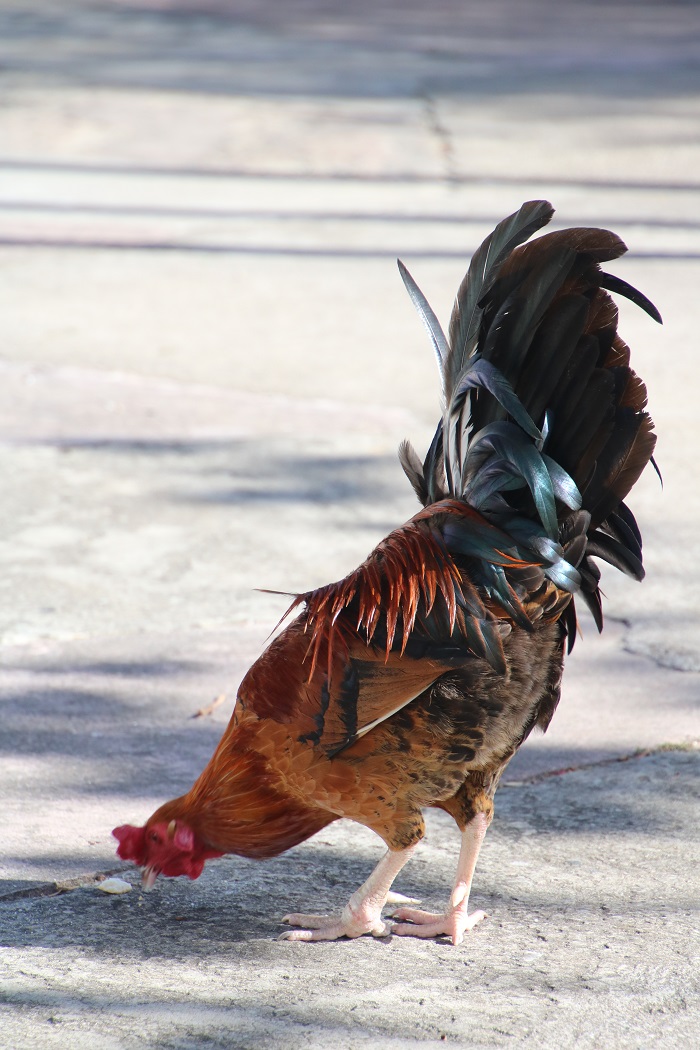 Before we left Deshais Guadeloupe to sail down here a few days ago we were visited by a swarm of honey bees that tried to set up shop under our bimini. It was really alarming to see how many there were, thousands.
Before we left Deshais Guadeloupe to sail down here a few days ago we were visited by a swarm of honey bees that tried to set up shop under our bimini. It was really alarming to see how many there were, thousands. 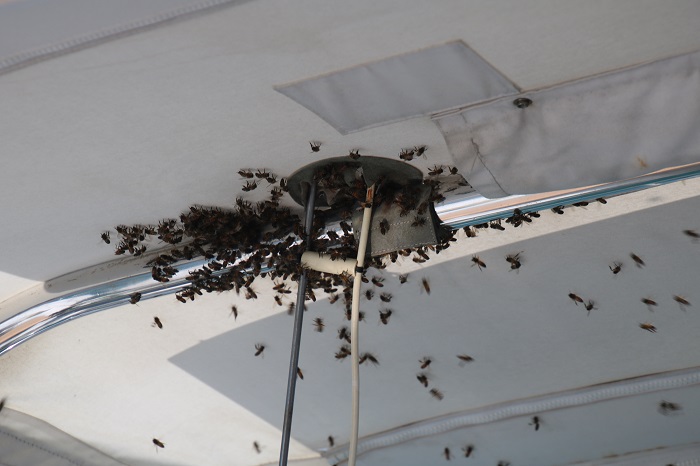 In only a few moments the “clump” grew in size.
In only a few moments the “clump” grew in size. 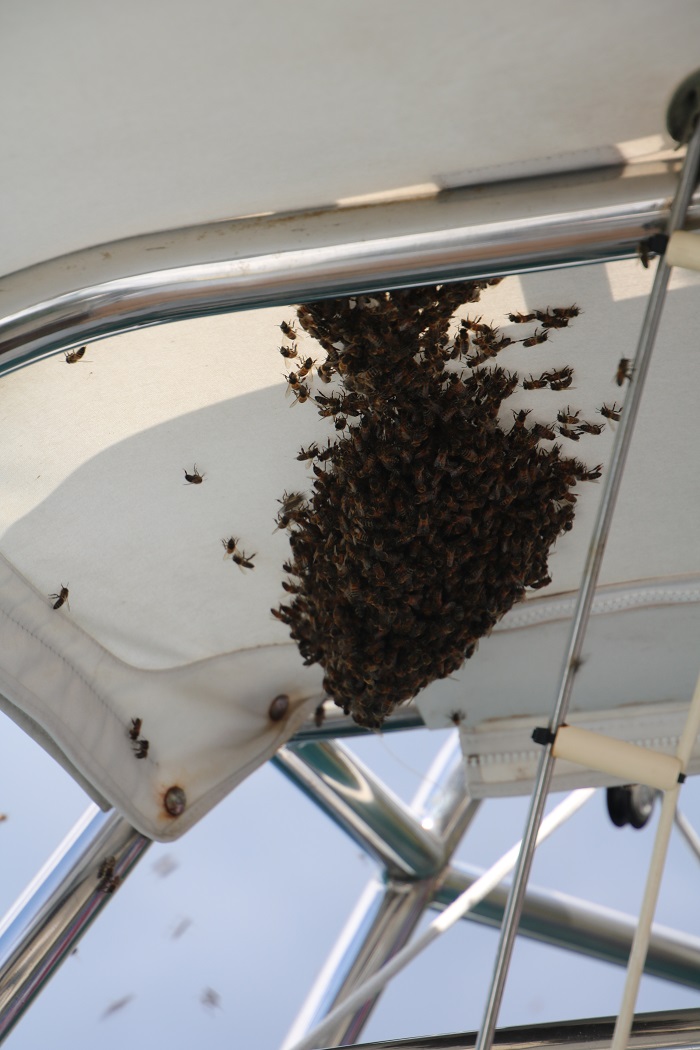 For more than an hour I tried everything to discourage them. I sprayed water, poked at them with a boat hook but nothing would deter them with more and more arriving every moment. No amount of harassing kept the swarm from growing to what looked like “pounds” of bees. Finally, when the mass doubled in size yet again I gave up and broke out a can of bug spray that I had put on board in anticipation of a possible roach problem in Cuba. I hated to do it but they were clearly settling in for a long visit. I didn’t see evidence of the queen but was really worried what might happen if she showed up.
For more than an hour I tried everything to discourage them. I sprayed water, poked at them with a boat hook but nothing would deter them with more and more arriving every moment. No amount of harassing kept the swarm from growing to what looked like “pounds” of bees. Finally, when the mass doubled in size yet again I gave up and broke out a can of bug spray that I had put on board in anticipation of a possible roach problem in Cuba. I hated to do it but they were clearly settling in for a long visit. I didn’t see evidence of the queen but was really worried what might happen if she showed up.
At first the spray just riled them up and then they would just settle into another spot on the bimini. Then they started to coat the solar panels. More spraying and a LOT of VERY pissed-off bees. Finally, after a few hours they were gone. Amazingly, I didn’t get stung.
The next day we moved on and sailed down the leeward side of Guadaloupe. It’s interesting to make passage down the lee side of a large island like Guadaloupe, with mountains that are thousands of feet high, as the winds can be quite variable as they tumble over the highlands. Deshais harbor, in particular, is known for funneling the winds so that anything more than 15kts on the windward side of the island blasts through the harbor at twice that speed.
It was plenty windy as we pulled up the anchor in Deshais, gusting to the mid 20s, but by the time we were a few miles out the wind settled down nicely and we had a terrific sail down island, hitting more than 9kts through the water a few times. And, all of that on perfectly smooth water.
We had been told that as you approach either end of a large island, the wind funnels past the headlands boosting the wind speed to about 10kts more than the actual or gradient wind. This only lasts for a few miles, either side of the headlands, and then settles down again. The wind direction is also “bent” or diverted so that while we were on a beam reach for much of our trip, we suddenly found ourself hard on the wind with 25kts+ as we rounded the point.
Fortunately, things settled down again a few miles out so we were able to find our way here with a minimum of fuss.
Sailing between islands that are so mountainous is a very different experience for us, especially when compared with the low lying Bahamas where the land has no effect on the wind. It’s also a lot less stressful with thousands of feet of water under the boat when compared to mere feet in the Bahamas.
So, here we are visiting yet another charming and oh-so-French island. Brenda has declared that it’s the prettiest place that we have ever visited. That’s good as we will likely be here for about a week as some weather is developing north of the Bahamas that will likely bring adverse winds to this part of the eastern Caribbean. With that in mind, we will just stay put till things settle down later in the week and not probably not venture any further south on this trip.
After that, we will head back to Antigua in anticipation of Brenda’s flight home.
Perhaps I’ll close with a shot of town from the bow of Pandora. Yes, a really charming spot and a good one to be “weathered” into. Such are the compromises of the disadvantaged cruiser. 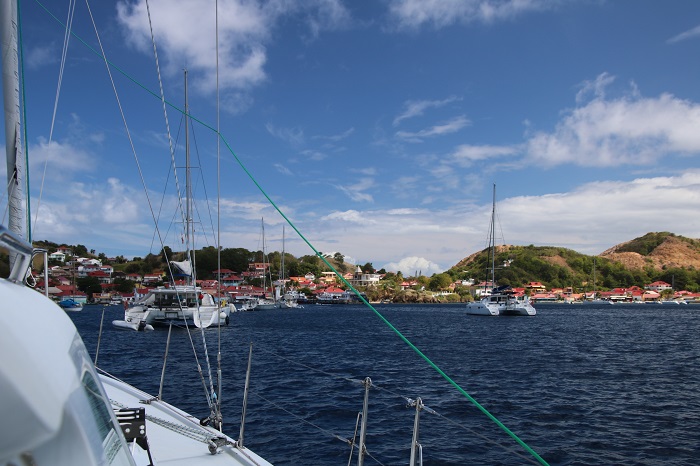 Somehow we will just have to cope. Wish us luck.
Somehow we will just have to cope. Wish us luck.

5 responses to “Le Saintes, weathered into a French gem”